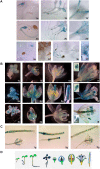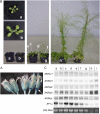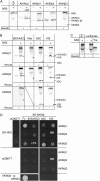Beta-subunits of the SnRK1 complexes share a common ancestral function together with expression and function specificities; physical interaction with nitrate reductase specifically occurs via AKINbeta1-subunit
- PMID: 18768910
- PMCID: PMC2577271
- DOI: 10.1104/pp.108.123026
Beta-subunits of the SnRK1 complexes share a common ancestral function together with expression and function specificities; physical interaction with nitrate reductase specifically occurs via AKINbeta1-subunit
Abstract
The SNF1/AMPK/SnRK1 kinases are evolutionary conserved kinases involved in yeast, mammals, and plants in the control of energy balance. These heterotrimeric enzymes are composed of one alpha-type catalytic subunit and two gamma- and beta-type regulatory subunits. In yeast it has been proposed that the beta-type subunits regulate both the localization of the kinase complexes within the cell and the interaction of the kinases with their targets. In this work, we demonstrate that the three beta-type subunits of Arabidopsis (Arabidopsis thaliana; AKINbeta1, AKINbeta2, and AKINbeta3) restore the growth phenotype of the yeast sip1Deltasip2Deltagal83Delta triple mutant, thus suggesting the conservation of an ancestral function. Expression analyses, using AKINbeta promoterbeta-glucuronidase transgenic lines, reveal different and specific patterns of expression for each subunit according to organs, developmental stages, and environmental conditions. Finally, our results show that the beta-type subunits are involved in the specificity of interaction of the kinase with the cytosolic nitrate reductase. Together with previous cell-free phosphorylation data, they strongly support the proposal that nitrate reductase is a real target of SnRK1 in the physiological context. Altogether our data suggest the conservation of ancestral basic function(s) together with specialized functions for each beta-type subunit in plants.
Figures







Similar articles
-
AKINbeta3, a plant specific SnRK1 protein, is lacking domains present in yeast and mammals non-catalytic beta-subunits.Plant Mol Biol. 2004 Nov;56(5):747-59. doi: 10.1007/s11103-004-5111-1. Epub 2005 Mar 24. Plant Mol Biol. 2004. PMID: 15803412
-
The hybrid four-CBS-domain KINβγ subunit functions as the canonical γ subunit of the plant energy sensor SnRK1.Plant J. 2013 Jul;75(1):11-25. doi: 10.1111/tpj.12192. Epub 2013 May 15. Plant J. 2013. PMID: 23551663 Free PMC article.
-
SnRK1 from Arabidopsis thaliana is an atypical AMPK.Plant J. 2015 Apr;82(2):183-92. doi: 10.1111/tpj.12813. Plant J. 2015. PMID: 25736509
-
Plant SnRK1 Kinases: Structure, Regulation, and Function.Exp Suppl. 2016;107:403-438. doi: 10.1007/978-3-319-43589-3_17. Exp Suppl. 2016. PMID: 27812990 Review.
-
Molecular Insights into the Enigmatic Metabolic Regulator, SnRK1.Trends Plant Sci. 2016 Apr;21(4):341-353. doi: 10.1016/j.tplants.2015.11.001. Epub 2015 Nov 28. Trends Plant Sci. 2016. PMID: 26642889 Review.
Cited by
-
Distinct gene networks modulate floral induction of autonomous maize and photoperiod-dependent teosinte.J Exp Bot. 2018 May 25;69(12):2937-2952. doi: 10.1093/jxb/ery110. J Exp Bot. 2018. PMID: 29688423 Free PMC article.
-
Direct and indirect responses of the Arabidopsis transcriptome to an induced increase in trehalose 6-phosphate.Plant Physiol. 2024 Sep 2;196(1):409-431. doi: 10.1093/plphys/kiae196. Plant Physiol. 2024. PMID: 38593032 Free PMC article.
-
Compartmentalization, a key mechanism controlling the multitasking role of the SnRK1 complex.J Exp Bot. 2022 Nov 15;73(20):7055-7067. doi: 10.1093/jxb/erac315. J Exp Bot. 2022. PMID: 35861169 Free PMC article. Review.
-
PYRIDOX(AM)INE 5'-PHOSPHATE OXIDASE3 of Arabidopsis thaliana maintains carbon/nitrogen balance in distinct environmental conditions.Plant Physiol. 2023 Sep 22;193(2):1433-1455. doi: 10.1093/plphys/kiad411. Plant Physiol. 2023. PMID: 37453131 Free PMC article.
-
Default Activation and Nuclear Translocation of the Plant Cellular Energy Sensor SnRK1 Regulate Metabolic Stress Responses and Development.Plant Cell. 2019 Jul;31(7):1614-1632. doi: 10.1105/tpc.18.00500. Epub 2019 May 13. Plant Cell. 2019. PMID: 31123051 Free PMC article.
References
-
- Andersson U, Filipsson K, Abbott CR, Woods A, Smith K, Bloom SR, Carling D, Small CJ (2004) AMP-activated protein kinase plays a role in the control of food intake. J Biol Chem 279 12005–12008 - PubMed
-
- Baena-González E, Rolland F, Thevelein JM, Sheen J (2007) A central integrator of transcription networks in plant stress and energy signalling. Nature 448 938–942 - PubMed
-
- Bate N, Twell D (1998) Functional architecture of a late pollen promoter: pollen-specific transcription is developmentally regulated by multiple stage-specific and co-dependent activator elements. Plant Mol Biol 37 859–869 - PubMed
-
- Bouly JP, Gissot L, Lessard P, Kreis M, Thomas M (1999) Arabidopsis thaliana proteins related to the yeast SIP and SNF4 interact with AKINalpha1, an SNF1-like protein kinase. Plant J 18 541–550 - PubMed
Publication types
MeSH terms
Substances
LinkOut - more resources
Full Text Sources
Molecular Biology Databases

